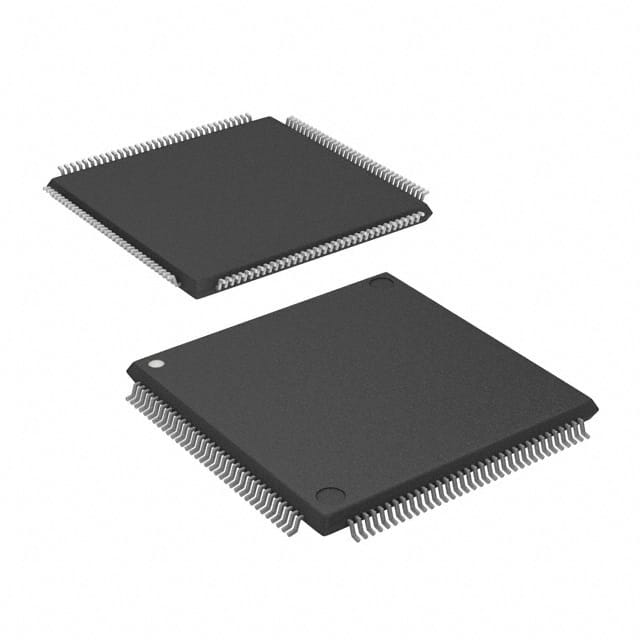Consulte las especificaciones para obtener detalles del producto.

LPC4333JBD144E
Product Overview
Category: Microcontroller
Use: The LPC4333JBD144E is a high-performance microcontroller designed for various applications in the embedded systems industry. It offers advanced features and capabilities to meet the demands of complex projects.
Characteristics: - High processing power - Dual-core architecture - Extensive peripheral set - Low power consumption - Rich connectivity options
Package: The LPC4333JBD144E comes in a 144-pin LQFP package, which provides ease of integration into different electronic systems.
Essence: This microcontroller combines powerful processing capabilities with a wide range of peripherals, making it suitable for applications that require high performance and connectivity.
Packaging/Quantity: The LPC4333JBD144E is typically sold individually or in small quantities, packaged in anti-static trays or tubes to ensure safe transportation and handling.
Specifications
- Processor: ARM Cortex-M4 and Cortex-M0 dual-core processors
- Clock Speed: Up to 204 MHz
- Flash Memory: 1 MB
- RAM: 264 KB
- Operating Voltage: 2.4V - 3.6V
- Operating Temperature: -40°C to +85°C
- Peripherals: USB, Ethernet, SPI, I2C, UART, GPIO, ADC, DAC, etc.
- Package Type: LQFP
- Pin Count: 144
Detailed Pin Configuration
The LPC4333JBD144E has a total of 144 pins, each serving a specific purpose. The pin configuration includes multiple GPIO pins, communication interfaces (UART, SPI, I2C), analog input/output pins (ADC, DAC), and power supply pins. A detailed pinout diagram can be found in the product datasheet.
Functional Features
- Dual-Core Architecture: The LPC4333JBD144E features two powerful ARM Cortex-M cores, allowing for efficient multitasking and improved performance.
- Rich Peripheral Set: With a wide range of peripherals, including USB, Ethernet, SPI, I2C, UART, ADC, and DAC, this microcontroller offers versatile connectivity options for various applications.
- High-Speed Connectivity: The integrated USB and Ethernet interfaces enable fast data transfer and communication with external devices.
- Low Power Consumption: The LPC4333JBD144E incorporates power-saving features and low-power modes to optimize energy efficiency in battery-powered applications.
Advantages and Disadvantages
Advantages: - High processing power enables the execution of complex tasks. - Dual-core architecture allows for efficient multitasking. - Rich peripheral set provides versatile connectivity options. - Low power consumption prolongs battery life in portable devices.
Disadvantages: - Higher cost compared to lower-end microcontrollers. - Steeper learning curve due to advanced features and capabilities.
Working Principles
The LPC4333JBD144E operates based on the ARM Cortex-M4 and Cortex-M0 dual-core processors. These cores work together to handle different tasks efficiently. The microcontroller executes instructions stored in its flash memory, interacts with peripherals, and communicates with external devices through various interfaces.
Detailed Application Field Plans
The LPC4333JBD144E is suitable for a wide range of applications, including but not limited to: - Industrial automation - Internet of Things (IoT) devices - Consumer electronics - Automotive systems - Medical equipment - Robotics
Its high processing power, rich peripheral set, and connectivity options make it an ideal choice for projects that require advanced functionality and performance.
Detailed and Complete Alternative Models
- STM32F407VG: A comparable microcontroller from STMicroelectronics, offering similar features and capabilities.
- PIC32MZ2048EFH144: A microcontroller from Microchip with comparable performance and a rich peripheral set.
- SAM4E16E: An Atmel microcontroller that provides similar functionality and connectivity options.
These alternative models can be considered based on specific project requirements, cost considerations, and compatibility with existing systems.
Word count: 524 words
Enumere 10 preguntas y respuestas comunes relacionadas con la aplicación de LPC4333JBD144E en soluciones técnicas
Sure! Here are 10 common questions and answers related to the application of LPC4333JBD144E in technical solutions:
Q: What is LPC4333JBD144E? A: LPC4333JBD144E is a microcontroller from NXP Semiconductors, based on the ARM Cortex-M4 core.
Q: What are the key features of LPC4333JBD144E? A: LPC4333JBD144E features dual-core architecture (Cortex-M4 and Cortex-M0), high-speed USB, Ethernet, multiple serial interfaces, and extensive peripheral options.
Q: What are some typical applications of LPC4333JBD144E? A: LPC4333JBD144E is commonly used in industrial automation, consumer electronics, medical devices, and Internet of Things (IoT) applications.
Q: How can I program LPC4333JBD144E? A: LPC4333JBD144E can be programmed using various development tools such as Keil MDK, IAR Embedded Workbench, or the NXP LPCXpresso IDE.
Q: What programming languages are supported for LPC4333JBD144E? A: LPC4333JBD144E supports programming in C and C++ languages.
Q: Can I use LPC4333JBD144E for real-time applications? A: Yes, LPC4333JBD144E is suitable for real-time applications due to its high-performance Cortex-M4 core and extensive peripheral support.
Q: Does LPC4333JBD144E have built-in communication interfaces? A: Yes, LPC4333JBD144E has multiple communication interfaces including UART, SPI, I2C, CAN, USB, and Ethernet.
Q: Can I connect external memory to LPC4333JBD144E? A: Yes, LPC4333JBD144E supports external memory interfaces such as SDRAM, NOR Flash, and NAND Flash.
Q: Is LPC4333JBD144E suitable for low-power applications? A: Yes, LPC4333JBD144E offers various power-saving features like multiple sleep modes and wake-up sources, making it suitable for low-power applications.
Q: Are there any development boards available for LPC4333JBD144E? A: Yes, NXP provides LPCXpresso and LPC-Link development boards that are compatible with LPC4333JBD144E, allowing easy prototyping and evaluation of the microcontroller.
Please note that these answers are general and may vary depending on specific requirements and implementation details.

